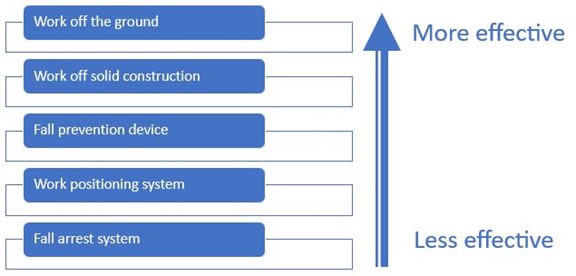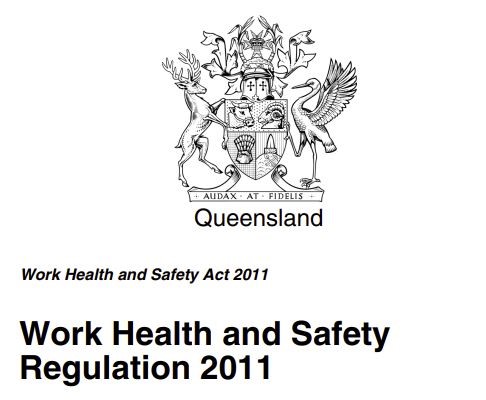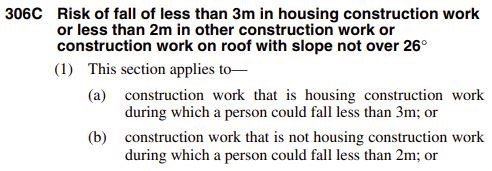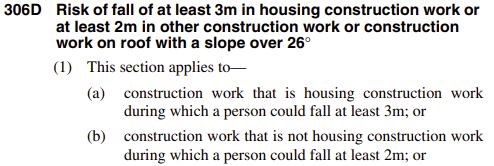Working at Heights Regulations: Legal Obligations for PCBUs
Working at Heights Regulations Explained
Working at heights is a common practice on many work sites. This type of work poses significant risks and working at heights is one of the leading causes of fatalities and serious injuries in Australian workplaces. In this article we aim to explain the working at heights regulations for PCBUs under the Harmonised WHS Regulations.
Working at Heights Under WHS Regulations
The Harmonised WHS Legislation has 2 main sections that discuss working at heights. These are referred to as “falls” in Part 4.4 and work that “involves a risk of person falling more than 2 metres” in Section 291 Meaning of High Risk Construction Work.
WHS Regulations Part 4.4 – Falls
Part 4.4 of the regulations outlines the requirements for PCBUs to manage the risks of falls. This section covers any situation where a worker could fall from one level to another. That doesn’t mean that workers always need a harness, it just means that steps need to be taken to ensure the prevention of falls.
S(78) – Management of Risk of Fall
S(78) provides some examples of fall hazards, including:
- An elevated workplace (e.g. a roof)
- An opening through which someone could fall (e.g. a skylight or void)
- An edge over which someone could fall (e.g. off the edge of scaffolding)
- A surface through which someone could fall (e.g. a fragile mezzanine roof)
- Any other place from which a person could fall
The regulation then states that, if possible, the work must be completed off the ground or off a solid construction, with a solid construction described as an area that:
- Is capable of supporting all persons
- Has barriers around its perimeter
- Has an even and readily negotiable surface
- Has safe means of entry and exit
S(79) – Minimise Risk of Fall
S(79) is only applicable if the PCBU is unable to eliminate the risk of a fall using the controls outlined in s(78) (i.e. work off the ground or work off solid construction). These fall protection methods offer less protection than those listed in (s)79 and are (in order):
- Provision of a fall prevention device (e.g. a temporary work platform or a secure fence / guard rail)
- Provision of a work positioning system (e.g. a fall restraint system)
- Provision of a fall arrest system
Its important that these controls are viewed IN ORDER, as the regulations require that each of the earlier controls be used, if possible, with later controls only allowed if those listed earlier are not reasonably practicable. These form a hierarchy of control, as detailed below:

S(79) also provides some exceptions where these requirements would be problematic if not impossible, which are:
- The performance of stuntwork
- The performance of acrobatics
- A theatrical performance
- A sporting or athletic activity
- Horse riding
S(80) – Emergency and Rescue Procedures
S(80) provides the legal requirements and are only applicable when a fall arrest system is being used as a control measure. This section states that:
- An emergency rescue procedure must be established
- The emergency rescue procedure must be tested to ensure it is effective
- Workers must be trained in the emergency rescue procedure
WHS Regulations Chapter 6 – Construction Work
Chapter 6 of the Work Health and Safety Regulations covers construction work, with definitions and requirements for high risk construction work.
S(291) – Meaning of High Risk Construction Work
Section 291 of the WHS regulation defines high risk construction work. There are many types of high risk construction work but the one that we are concerned with is construction that “involves a risk of person falling more than 2 metres”. This is where the “2m rule” that many of us are familiar with comes from. What many of us don’t know is that, legally, it only relates to the construction industry. That being said, it is a good rule of thumb for all industries as falls from this height (or higher) can be fatal.
S(299, 300, 301 and 302) – SWMS
Seeing that this type of working at heights is considered high risk construction work, Section 299 through 302 apply. These section relate mostly to Safe Work Method Statements (SWMS), and require that the PCBU in charge of the works:
- Ensure that a SWMS is prepared
- Ensure that workers comply with the SWMS
- Provide a copy of the SWMS to the principal contractor (if relevant)
- Review the SWMS to ensure it remains effective
Are There State Specific Working at Heights Regulations?
Although most states have adopted the Harmonised Regulations, they still make changes or updates. We like to call this the “de-harmonisation process” as the legislation is slowly but surely looking different across each state. Many states (including NSW and QLD) have added more requirements for working at heights.
Queensland’s Working at Heights Regulations
 In Chapter 6 “Construction work”, QLD has added several extra working at heights regulations for both housing (or residential) construction and general construction. The two classes of working at heights are work that involves:
In Chapter 6 “Construction work”, QLD has added several extra working at heights regulations for both housing (or residential) construction and general construction. The two classes of working at heights are work that involves:
- Risk of a person falling less than 3m in housing construction and less than 2m in general construction (or roof slope less than 26deg)
- Risk of a person falling at least 3m in housing construction and more than 2m in general construction (or roof slope over 26deg)
Some exceptions are provided, including work that involves:
- a ladder or fixed ladder
- a platform supported by trestle ladders
- scaffolding that the person is erecting or dismantling
- an area near a ladder that the person needs to use to get on or off the ladder
s(306C) – Less Than 3m (housing construction) and Less Than 2m (general construction)

This section essentially states that the workplace hazards must be identified with a risk assessment and appropriate controls implemented. Some examples of hazards are given, including:
- vertical reinforcing steel, or the edge of a rubbish skip, 1m below a surface from which the work is to be done
- unsheeted floor bearers and joists 2m below a surface from which the work is to be done
- a brittle roof on which the work is to be done 2m above a floor
s(306D) – More Than 3m (housing construction) and More Than 2m (general construction)

This section essentially states that when working at these heights, the PCBU must use controls to prevent the person falling any distance. For example , edge protection or a travel restraint system. If preventing the fall is not possible, only then can the PCBU consider controls to arrest the person’s fall. Steps must also be taken to minimise the risk during fall arrest.
Please note, the same exceptions exist as s306(C).
Extra Regulations for QLD Only
Extra working at heights regulations are provided to give practical guidance for a range of measures:
- s306(E) Edge protection
- s306(F) Fall protection cover
- s306(G) Travel restraint system
- s306(H) Fall arrest platform
- s306(L) Fall arrest harness
- s306(J) Safety net
- Subdivision 3 Ladders and trestles
- Subdivision 4 Scaffolding
We hope this guide helps you better understand the working at heights regulations. For more information please call one of our friendly consultants.
